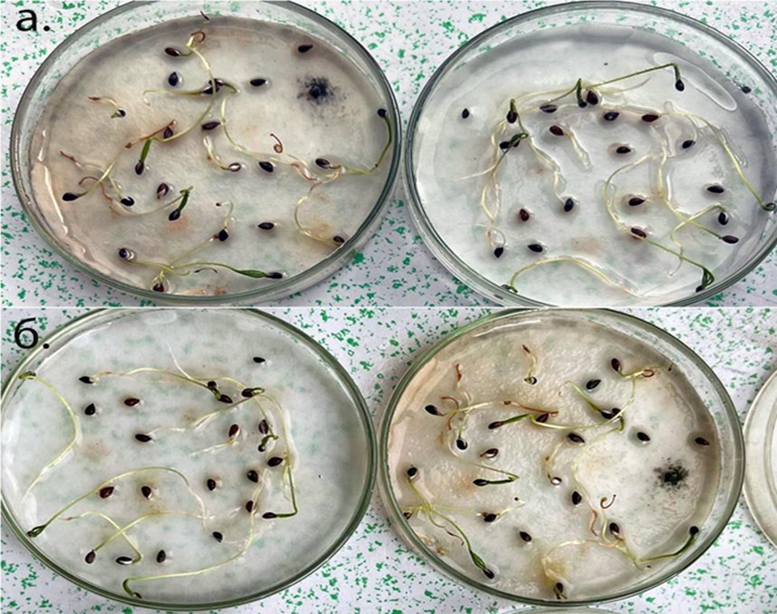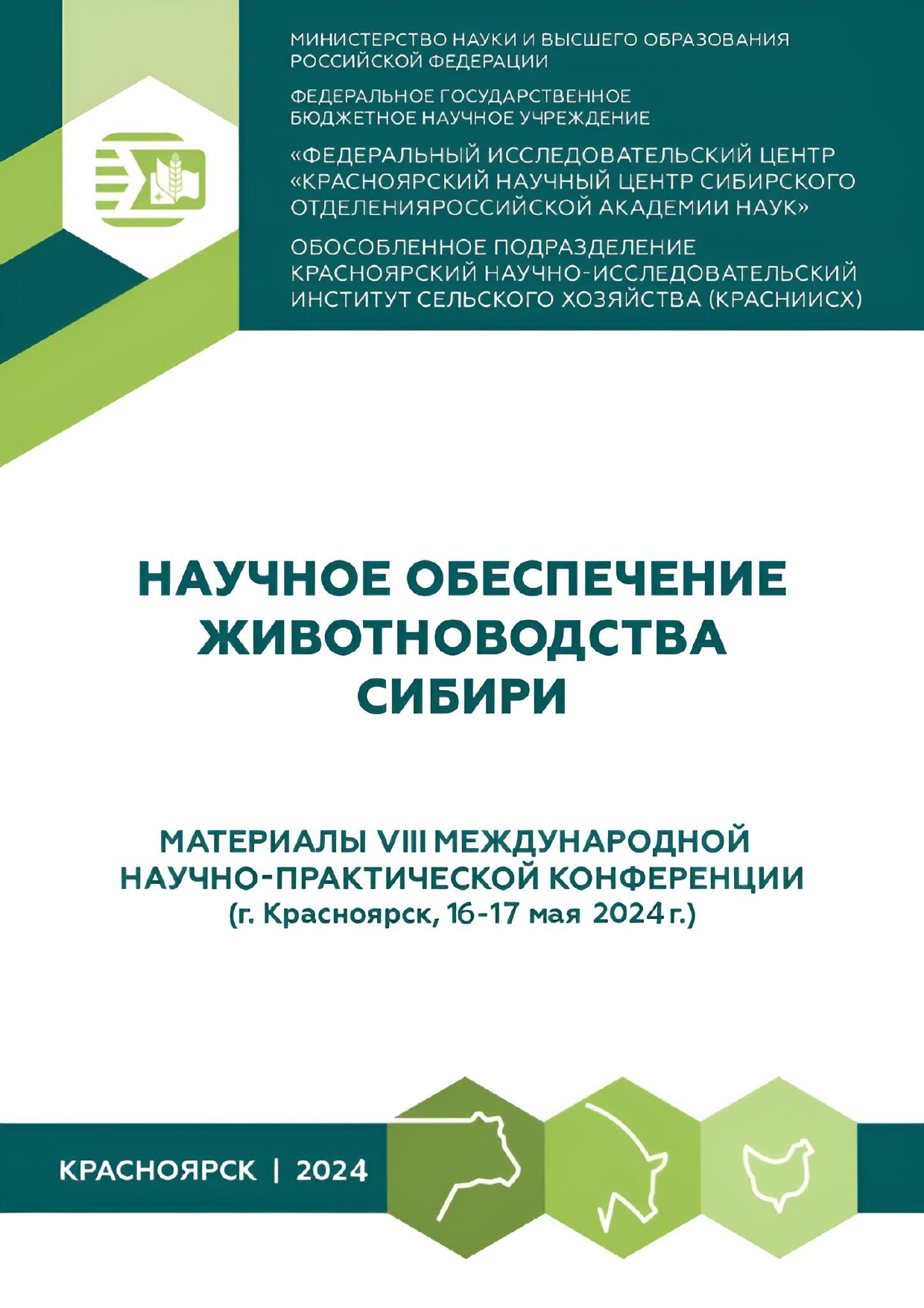Russian Federation
Russian Federation
Only one species of Siberian spruce (Picea obovata Ledeb) is distributed in Mongolia. It is a coniferous tree that forms a forest in a limited area, resembling a ridge-like strip along the border of the Larch and Siberian pine forests. Siberian spruce seeds are oval-boat-shaped, measuring 3.89 mm in length and 2.03 mm in width. A thousand seeds weigh 4.3 g and have a black-brown or brown-brown color with a smooth surface. At a temperature of +20°C in the laboratory thermostat, seed germination reaches 77%, with a growth rate of 6.9 days and a growth uniformity of 2.6 seeds. Conversely, at +25°C, seed germination decreases to 51%, with a growth rate of 7.68 days and a growth uniformity of 1.9 seeds. At room temperature of +22°C, the average germination rate was 19%, with a growth period of 14.5 days and a growth rate of 2.25 seeds per day.
Seed shape, size, germination, temperature, growth rate, growth uniformity
Introduction. Siberian spruce (Picea obovata Ledeb) is found across a vast region extending from the Ural Mountains in the west to Magadan Oblast in the east, and it stretches southward from the arctic tree line to the Altai Mountains in northwestern Mongolia [2].
There are approximately 40 species of spruce worldwide, and the Siberian spruce, belonging to the subspecies of true spruce, is one of the species that grows in Mongolia[11].
Spruce forests are widespread along the riverbanks in Khentii and Khovsgol in northwestern Mongolia, along the Khan-Khukhii and Khanhil Tsagi rivers, at the source of the Hovd River in the Mongolian Altai Mountains, at the mouth of the Altai tributary south of the Dayan Mountains, as well as in Bayan-olgii province, in the Yeru River's branch river valleys. These forests thrive on moist, fertile soil, typically transitioning from larch forests to cypress forests, forming small, isolated forest patches. Siberian spruce predominantly grows in river valley forests, in the upper region of the forest zone, characterized by dense shade, debris accumulations, canyon entrances, ridge-like formations at the border of larch and cedar forests, and in narrow river valleys [1].
Coniferous trees play a crucial role in Mongolia's forest reserves, serving as vital oxygen producers through year-round photosynthesis. They also contribute to reducing greenhouse gases, support green building initiatives, facilitate horticulture, aid in mining restoration efforts, and play a significant role in mitigating land degradation.
In our country, there have been limited studies on conifer embryos, seeds, and seed cultivation experiments. Therefore, we conducted a study on the morphology and laboratory germination of Siberian spruce (Picea obovata Ledeb) seeds available in the market.
In this study, we examined the morphological characteristics of Siberian spruce seeds and their laboratory germination capacity. We calculated the germination percentage, growth rate in days, and growth uniformity based on the number of seeds germinated per day.
Materials and methods. In this study, seeds acquired from the market in 2022, imported from Novosibirsk, Russia, were utilized.
The seed samples were meticulously cleaned to remove any fruit and mechanical impurities. Mature seeds were then weighed using an analytical balance with an accuracy of 0.001 g in four repetitions, and the weight of 1000 seeds was determined. Morphological characteristics of the seeds were observed and recorded using binoculars. Additionally, 80 seeds were selected for measurement, and photographs were captured using a digital camera. Measurements were conducted using the ToupView3.7 program [3, 5], and numerical data from the measurements were processed using the Data Analysis program in Excel [6].
The laboratory germination of seeds was assessed through germination tests conducted in both a thermostat and a room setting. For the laboratory germination test, 25 seeds were counted (in four repetitions) and placed in a Petri dish. The germinated seeds were then monitored and allowed to grow for 14 days at temperatures of +20°C and +25°C in a thermostat, and at +20°C in the room for 15-20 days. The number of germinated seeds, germination percentage (%), growth rate, and uniformity were calculated using the following formulas. It includes:
 (1)
(1)
where: T – Growth rate, days;
t – Average germination, time;
N-t – Number of seeds germinated per day.
 (2)
(2)
where: Tuniformity – Growth uniformity, pieces;
ntotal – Total number of germinated seeds;
ttotal – Total germination time [5].
Results. Siberian spruce (Picea obovata Ledeb) seeds exhibit an oval-boat shape, with lengths ranging from 2.76 to 5.62 mm (mean length: 3.89 ± 0.06 mm) and widths ranging from 1.53 to 2.68 mm (mean width: 2.03 ± 0.02 mm). The seeds have a black-brown to brownish-brown coloration and a smooth surface. A distinctive feature is the visible hilum, appearing as a white hole at the tip of the seed. The average weight of 1000 seeds ranges from 4.3 to 4.6 g.
(Figure 1).

Figure 1 – Morphology of Siberian spruce seeds
а-б. Seed shape в. Seed size
According to the laboratory germination tests conducted at +20°C, germination commenced at a rate of 40-44% on the 6th-7th day in the thermostat. By the 10th-12th day, complete germination was achieved, ranging from 68-84%. The average germination rate in the thermostat was found to be 77%, with a growth rate of 6.64-7.3 days. The growth rate was observed to be 2-3 shoots per day.
At a temperature of +25°C, germination began on the 6th-7th day, with a rate of 20-24%. By the 10th-12th day, full germination was achieved, ranging from 40-72%. In the thermostat, the average germination rate was 51%, with a growth rate of 7.27-8.2 days. The growth rate was measured at 1.6-2.5 shoots per day. The average performance of laboratory germination is presented in the table (Table 1; figure 2).
Table 1 – The results average seed germination studies of (Picea obovata) L
|
№ |
The name of the plant |
In the thermostat +20 |
In the thermostat +25 |
||||
|
Germi-nation, % |
Growth rate (days) |
Growth uniformity (flaky) |
Germi-nation, % |
Growth rate (days) |
Growth uniformity (flaky) |
||
|
1 |
Sibierian spurce (Picea obovata L) |
77 |
6.9 |
2.6 |
51 |
7.68 |
1.9 |

Figure 2 – Germination of thermostable seeds in the laboratory
а. Germination in a thermostat at +20°C б. Germination in a thermostat at +25°C
However, at room temperature of +22°C, 32 seeds were sown in a clay pot with 2 seeds each, totaling 64 seeds. Out of these, 14 seeds successfully sprouted. Germination at +22°C began at 4.68% on the 3rd-4th day and reached 21% on the 6th-7th day. The average germination rate in the chamber was 19%, with a growth rate of 14.5 days, and an average of 2.25 flasky sprouts per day (Figure 3).

Figure 3 – Germination of Siberian spruce seeds in pots at 22°C
Discussion. Siberian spruce is commonly planted and propagated through cuttings. As part of the Science and Technology Fund project, when spruce was planted in a log, the average height of 7-year-old seedlings measured 50 cm, with a diameter of 1.5 cm. The crown extended 15-20 cm in length, oriented from west to east and from north to south [10].
Since 2002, researchers from the Institute of Geoecology of the Academy of Sciences, Ts. Dashzeveg and S. Amartuvshin, have been conducting research on the cultivation of Siberian cedar and Siberian spruce in Unegleg’s Am, specifically in the area of Tunkhel Bag, Mandal Sum, Selenge Province. Spruce seeds collected in 2001 from forests near the city of Krasnoyarsk in the Russian Federation were utilized. These seeds demonstrated a techn germination rate of 80.3%, with an intensity of seed growth of 24.0% in one week, and a weight of a thousand seeds measured at 5.4 g. Their research concluded that it is suitable to plant these seeds between May 25 and June 5 in the spring for optimal growth of Siberian fir seedlings [8, 9].
Russian scientists have conducted extensive research on spruce seeds and cultivation methods. Fir seeds were planted both in a greenhouse and in an open field, and various parameters such as irrigation rate, air temperature, relative humidity, and shading were studied and controlled [7].
The results showed that the seedlings grown in the greenhouse exhibited higher height (by 52.4%) and diameter (by 62.3%) compared to those grown in the open field. Moreover, the biomass accumulation of the greenhouse-grown seedlings was significantly increased, reaching 128.1%. In a three-year observation period, it was noted that stem biomass constituted a higher proportion of greenhouse-grown seedlings, whereas conifer biomass was predominant in open-field seedlings. Stable conditions in the greenhouse, including high relative humidity (above 75%) with a daily irrigation norm of 20 liters and an internal temperature of 25°C (40% shading), were found to be crucial for the growth and biomass accumulation of seedlings. Therefore, for the propagation of Picea obovata for forest regeneration purposes, greenhouse seedling production is recommended [4].
The researchers mentioned above conducted germination tests for Siberian spruce seeds by planting them in both greenhouses and outdoor fields. In contrast, we conducted our germination tests under laboratory conditions. Despite the different testing environments, the results of our research, including temperature and water content parameters, were found to be similar.
In the future, there is a growing need and requirement to conduct experiments with Spruce seeds in laboratory settings using mycorrhiza, various fertilizers, and bio-activators.
Conclusion. 1. Siberian spruce (Picea obovata Ledeb) seeds are oval-boat-shaped, measuring 3.89 mm in length and 2.03 mm in width. A thousand seeds weigh 4.5 g and have a black-brown to brown-brown color with a smooth surface. The seed hilum is located at the end of each seed, appearing light in color and dot-like in appearance.
2. At a thermostat temperature of +20°C, the average germination rate was 77%, with a growth rate of 6.9 days and a growth uniformity of 2.6 seeds. However, at a thermostat temperature of +25°C, the seed germination rate dropped to 51%, with a growth rate of 7.68 days and a growth uniformity of 1.9 seeds. Additionally, at room temperature (+22°C), the average germination rate was 19% with a growth rate of 14.5 days, and the growth rate was measured at 2.25 sprouts per day.
3. Based on the results of the research, laboratory germination tests were conducted on Siberian spruce (Picea obovata L) seeds sold in the market for afforestation, horticulture, and biological restoration, at temperatures ranging from 20-25°C. A preliminary conclusion has been reached that it is more effective to prepare seedlings in a greenhouse before planting them outdoors in open fields or in containers.
1. Bat-Erdene, J. (2017). About the forest. Textbook UB. – P. 256.
2. Bat-Erdene J., Bazarsad Ch., Tsengel (2011). The main tasks of forestry. Textbook UB. – P. 93.
3. Binderiya, G. (2016). Seed morphology, anatomy and embryology of some species of Berberidaceae Juss. Thes is of doctor degree. UB, Mongolia.
4. Damdinjamts J., Ganbaatar B., Nachin B. (2021). A comparative study of the seedling production technology of Picea obovata L in the forest-steppe ecotone of northern Mongolia. https://acrobat.adobe.com/id/urn:aaid:sc:AP:81adfff0-acd2-4f8b-b0ed-8e3a1b74f5f2.
5. Ganbaatar S. (2016). Seed science. Textbook UB. – P. 17.
6. Jambaldorj J. (2011). Datanalyst and Solver programs. Mongolian state university of Agriculture. Textbook UB. – P. 3-9.
7. Sarsekova D., Ayan S., Abzhonow Z., Nurlabi A. (2021). Preliminary Results of the effect of Artificial Mycorrization on the growth of siberian spruse Picea obovata Ledeb. Seedlings and soil Properties https://acrobat. adobe.com/id/urn:aaid:sc:AP:e70d4fd7-9c03-431c-be42-7f552521808e.
8. Nakvasinal N., Nadezhda A., Demina, Nadezhda A., Prozherina (2017). Evaluation of survival and growth of Picea abies (L.) H. Karst. and Picea obovata Ledeb. Provenances in the north of Russia Elena https://acrobat.adobe.com/id/urn:aaid:sc:AP:964a58e9-9ffa-4b9d-9a2f-c99f8724466f.
9. Zhulanov A., Chertov N., Nechaeva Y., Pechenkina V., Zhulanova L., Boronnikova S., and Kalendar R. (2023). Genetic Uniqueness and Genetic Structure of Populations of Picea obovata Ledeb. and Larix sibirica Ledeb. in the Northern and Middle Urals https://acrobat.adobe.com/id/urn:aaid:sc:AP:f4e7a796-b525-4b9d-b0c1-44f8fa8c7f8e.
10. https://stf.gov.mn/archives/portfolio/borogtsootoi-suulgats.






